2.6. IMPLICATIONS AND RECOMMENDATIONS
Anthropogenic riverine inputs of N, P, and sediment have led to undesirable consequences in the coastal marine environment, including eutrophication and associated oxygen depletion, declines in water transparency, loss of submerged aquatic vegetation, and shifts in the composition of plankton communities (Boesch et al., 2001; Breitburg et al., 2018; Cloern, 2001; Degobbis, 1989; Diaz & Rosenberg, 2008; Giani et al., 2012; Kemp et al., 2005). Therefore, reduction of watershed inputs has been a management priority for many coastal marine systems, including CB and the NAS. A review of parallel time‐series data on hypoxia and watershed loading rates in coastal ecosystems shows that oxygen conditions tend to improve rapidly and linearly when the primary driver targeted for control is nutrients from wastewater treatment plants (Kemp et al., 2009). In larger more open systems, where nonpoint nutrient loads are more important in fueling eutrophication, responses to remediation tend to be nonlinear with hysteresis and time‐lags. Nonetheless, there have been some signs of ecosystem recovery. For CB, water quality improved with time during 1985–2016, which is statistically linked to the reduction of riverine inputs of TN (Zhang et al., 2018). For the NAS, the reduction of riverine loads of P has been an effective method to alleviate eutrophication, even with high inputs of N and silicates (Djakovac et al., 2012; Giani et al., 2012). However, ecosystem conditions in this posteutrophic phase are still not comparable to those in pristine environments due to the occurrence of hypoxia and degraded benthic habitats in shallow coastal zones (Alvisi & Cozzi, 2016; Stachowitsch, 2014). Thus, continued reduction of watershed loads is indispensable for both CB and the NAS.
After decades of management efforts, the goals of CB and the NAS restoration have not yet been fulfilled (Volf et al., 2018; Zhang et al., 2018). Moving forward, we provide the following recommendations:
continue monitoring river flows and water quality in the major tributaries to CB and the NAS;
improve statistical approaches for quantifying riverine constituent loads and trends, including associated uncertainties;
increase understanding of watershed factors that influence riverborne loads and trends (e.g., land use, hydrology, source controls) and their relative importance;
develop consensus and solutions among stakeholders to address the major challenges that hinder the achievement of restoration goals in a timely fashion (e.g., legacy sources, climate change, and reservoir filling);
increase understanding of the effects of land‐based inputs on downstream water quality and ecological responses (e.g., dissolved oxygen, water clarity, chlorophyll‐a);
enhance public awareness of the impacts of anthropogenic nutrient loading, management goals and actions, progress toward achieving these goals, and major challenges.
In a world with seemingly ubiquitous nutrient enrichment and water‐quality degradation, past and future advancement in our scientific understanding on these two coastal ecosystems can be valuable resources that may guide and facilitate the protection and restoration of estuarine and coastal ecosystems in other geographical locations.
The authors thank many institutions for making the river monitoring data available, including the US Geological Survey, the Chesapeake Bay Program, the Environmental Agency of the Republic of Slovenia, the Croatian Meteorological and Hydrological Service, the European Environmental Agency, the Autorità di Bacino Distrettuale del fiume Po, the Regional Environmental Protection Agencies of Emilia Romagna, Veneto and Friuli Venezia Giulia for the NAS rivers. The editors and anonymous reviewers are greatly appreciated for their comments on an earlier draft of this chapter. This is contribution CN5869 of the University of Maryland Center for Environmental Science.
1 Alcamo, J., Flörke, M., & Märker, M. (2007). Future long‐term changes in global water resources driven by socio‐economic and climatic changes. Hydrological Sciences Journal, 52(2), 247–275. https://doi:10.1623/hysj.52.2.247
2 Alvisi, F., & Cozzi, S. (2016). Seasonal dynamics and long‐term trend of hypoxia in the coastal zone of Emilia Romagna (NW Adriatic Sea, Italy). Science of the Total Environment, 541, 1448–1462. https://doi:10.1016/j.scitotenv.2015.10.011
3 Ator, S.W., Brakebill, J.W., & Blomquist, J.D. (2011). Sources, fate, and transport of nitrogen and phosphorus in the Chesapeake Bay watershed: An empirical model (Scientific Investigations Report 2011‐5167, 27 pp.). Reston, VA: US Geological Survey.
4 Bachman, L.J., Lindsey, B., Brakebill, J., & Powars, D.S. (1998). Ground‐water discharge and base‐flow nitrate loads of nontidal streams, and their relation to a hydrogeomorphic classification of the Chesapeake Bay Watershed, middle Atlantic coast (Water‐Resources Investigations Report 98‐4059, 71 pp.). Baltimore, MD: US Geological Survey.
5 Basu, N.B., Destouni, G., Jawitz, J.W., Thompson, S.E., Loukinova, N.V., Darracq, A., et al. (2010). Nutrient loads exported from managed catchments reveal emergent biogeochemical stationarity. Geophysical Research Letters, 37(23), L23404. https://doi:10.1029/2010gl045168
6 Bloschl, G., Hall, J., Parajka, J., Perdigao, R.A.P., Merz, B., Arheimer, B., et al. (2017). Changing climate shifts timing of European floods. Science, 357(6351), 588–590. https://doi:10.1126/science.aan2506
7 Boesch, D.F., Brinsfield, R.B., & Magnien, R.E. (2001). Chesapeake Bay eutrophication: Scientific understanding, ecosystem restoration, and challenges for agriculture. Journal of Environmental Quality, 30(2), 303–320. https://www.ncbi.nlm.nih.gov/pubmed/11285890
8 Bortone, G. (2014). Il “Piano stralcio di lotta alla Eutrofizzazione” dell'Autorità del Po. sua adozione e applicazione. In A. Rinaldi (Ed.), Fioriture algali in Adriatico. Il bacino padano tra sviluppo e scienza (pp. 67–76). Imola: Editrice La Mandragora.
9 Boyer, E.W., & Howarth, R.W. (2008). Nitrogen fluxes from rivers to the coastal oceans. In D.G. Capone, D.A. Bronk, M.R. Mulholland, E.J. Carpenter (Eds.), Nitrogen in the marine environment (pp. 1565–1587). Amsterdam: Elsevier.
10 Boynton, W.R., Hagy, J.D., Cornwell, J.C., Kemp, W.M., Greene, S.M., Owens, M.S., et al. (2008). Nutrient budgets and management actions in the Patuxent River Estuary, Maryland. Estuaries and Coasts, 31(4), 623–651. https://doi:10.1007/s12237‐008‐9052‐9
11 Breitburg, D., Levin, L.A., Oschlies, A., Gregoire, M., Chavez, F.P., Conley, D.J., Garcon, V., et al. (2018). Declining oxygen in the global ocean and coastal waters. Science, 359(6371). https://doi:10.1126/science.aam7240
12 Carpenter, S.R., Caraco, N.F., Correll, D.L., Howarth, R.W., Sharpley, A.N., & Smith, V.H. (1998). Nonpoint pollution of surface waters with phosphorus and nitrogen. Ecological Applications, 8(3), 559–568. https://doi:10.1890/1051‐0761(1998)008[0559:Nposww]2.0.Co;2
13 Chanat, J.G., Moyer, D.L. Blomquist, J.D., Hyer, K.E., & Langland, M.J. (2016). Application of a weighted regression model for reporting nutrient and sediment concentrations, fluxes, and trends in concentration and flux for the Chesapeake Bay Nontidal Water‐Quality Monitoring Network, results through water year 2012 (Scientific Investigations Report 2015‐5133, 76 pp.). Reston, VA: US Geological Survey.
14 Charlton, M.B., Bowes, M.J., Hutchins, M.G., Orr, H.G., Soley, R., & Davison, P. (2018). Mapping eutrophication risk from climate change: Future phosphorus concentrations in English rivers. Science of the Total Environment, 613–614, 1510–1526. https://doi:10.1016/j.scitotenv.2017.07.218.
Читать дальше












